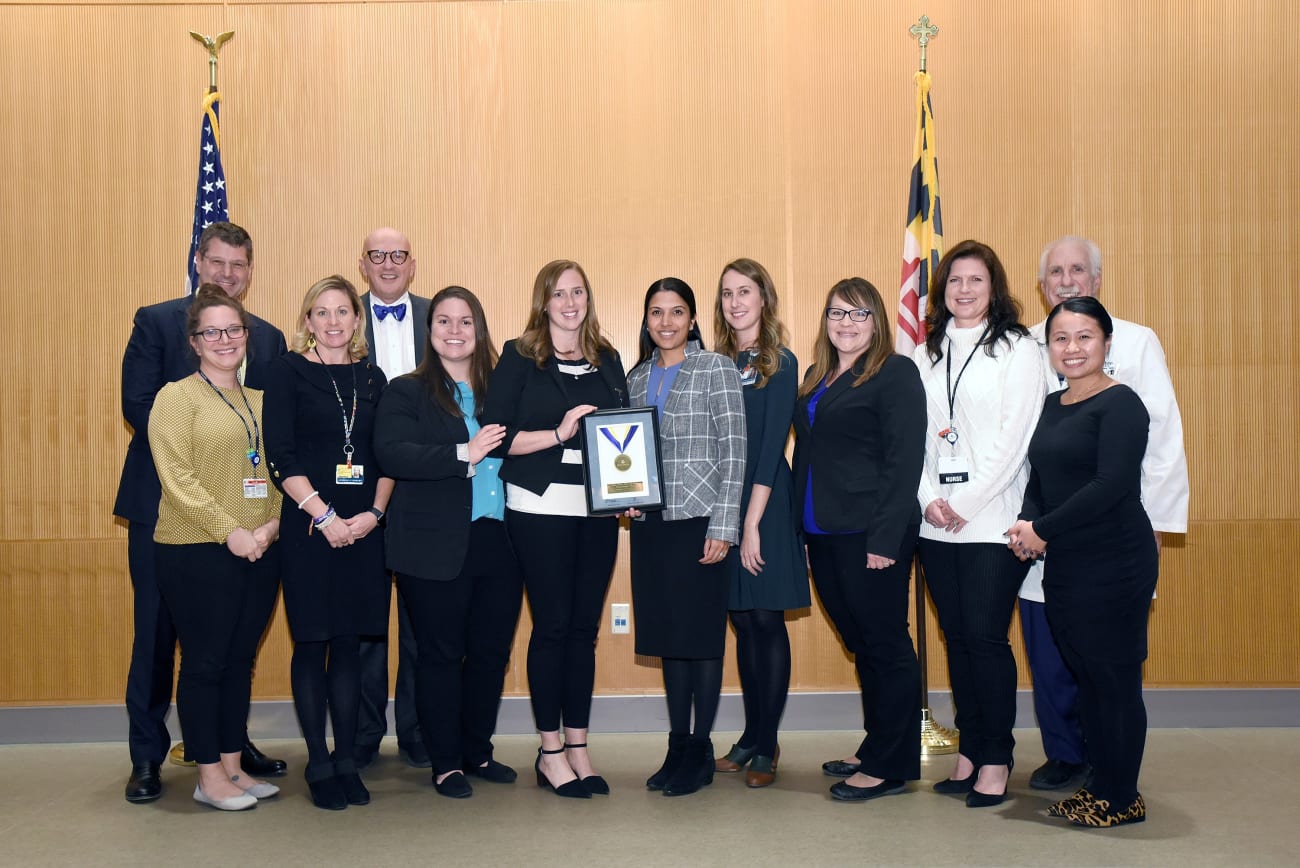
Nationally, over 20% of patients hospitalized for heart failure find themselves readmitted to a hospital within 30 days. However, for patients seen after hospital discharge at the Johns Hopkins Hospital Heart Failure Bridge Clinic, that readmission rate ranges between 9% and 12%.
Established in 2012, the clinic features a multidisciplinary team whose day-to-day work is led by certified heart failure nurse practitioners, in partnership with a community health worker, a pharmacist, nursing team and heart failure cardiologist and medical director Nisha Gilotra. Together, they focus on disease management that begins prior to discharge.
“Our mission is to get patients plugged into the clinic before they leave The Johns Hopkins Hospital, so they will be seen within a week after discharge,” Gilotra says. “They are then followed on a weekly basis for that first month or so to prevent readmission through clinical assessment, medication reconciliation and titrating, guideline-directed medical therapies for heart failure.”
Patients stay active with the clinic anywhere from a few months to a year, to longer than five years, says nurse practitioner Sarah Riley. Many patients are unaware of their underlying conditions and risk factors prior to their heart failure diagnosis.
“One of the huge benefits of this clinic is that we’re capturing those vulnerable patients who have barriers to health care for a variety of reasons and, often, the only time they get connected to the health system is when they land in the emergency department,” says Gilotra. “Our job is to help them manage their condition so that it doesn’t happen again.”
Connecting the Dots of Cardiac Care
For the many patients who do not have an established cardiologist upon visiting the clinic, the care team puts them in touch with one, says Riley. The clinic also refers patients to the Johns Hopkins Home Care Group to provide and manage at-home monitoring, using weight scales, blood pressure cuffs and other assistance. “With help from Johns Hopkins Home Care, we’re able to monitor the patient remotely on a daily basis for the first month or so,” says Riley. “This way, we can be sure they are on top of managing their condition.”
Because the No. 1 precipitant for hospitalization is congestion, “all that’s often required is close contact with the patient to be able to anticipate that and adjust their diuretics,” says Gilotra. “Or, we have them come into the clinic and actually get intravenous diuretics, and that can avoid hospitalization. We've demonstrated the safety of this approach with multiple patient populations within heart failure, whether it's heart failure with preserved ejection fraction or cardiac amyloidosis.”
In addition to the acute post-discharge patients, the clinic also sees chronic heart failure patients referred by cardiologists or other providers outside of Johns Hopkins Medicine, including primary care physicians. Some patients also self-refer. Access is never an issue, as patients can be seen on a same-day, next-day and same-week basis.
In addition to seeing a nurse practitioner, clinic patients work with a pharmacist to thoroughly understand their medications and dosing schedules. Then, a community health worker helps these patients address any social barriers to health after leaving the hospital setting, including housing, food and transportation.
New diets, especially ones requiring less than 2 grams of sodium per day, can be difficult to navigate for many patients. “It can be hard to realize that even though they might not use a salt shaker, they are consuming way too much sodium,” says Riley. “Our community health worker will actually go into the home to discuss staples and menus and then go shopping with them to help them pick out the right options. They’ll also talk about barriers that prevent them from attending any health care appointments — not just clinic visits — so they can better manage their chronic conditions.”
The clinic sees about 25 patients per day, and one in four patient visits results in administration of IV diuretics. “This is the crux of our ability to keep people out of the emergency department and prevent things from degenerating to the point of needing to be admitted to the hospital,” says Gilotra. In an attempt to share the successes of the clinic and grow similar programs within the medical community, the team has presented their experience at local and national academic meetings, and has hosted staff from other clinics to visit with the team.
Developing relationships with patients is extremely rewarding, say Gilotra and Riley. “Our patients really take their health care seriously, and they have a strong connection and trust in their provider team,” says Gilotra. “These patients have gone from essentially living in the hospital with heart failure to getting back home and improving their quality of life. And all it took was having a clinic like this to come into once a week for a check-in and adjustment of medications, following salt restrictions and fluid restrictions, and now they've been out of the hospital for a year. There are plenty of stories like that."

COVID-19 and the Heart Failure Bridge Clinic
The Johns Hopkins Hospital Heart Failure Bridge Clinic team, shown here, conducts more than 2,500 patient visits annually. In response to COVID-19, the majority of patient encounters have taken place via telemedicine visits, with a subset of patients clinically identified as needing further in-person clinic assessment.
“We have been able to manage the majority of these high-risk patients via telemedicine,” says cardiologist and clinic director Nisha Gilotra. “However, these in-person assessments are even more critical during this pandemic, as they can keep heart failure patients out of the hospital and therefore reduce their risk of acquiring COVID-19, while also reducing the current strain on the health care system’s capacity.”
To schedule appointments at the Heart Failure Bridge Clinic, please call the Cardiovascular Access Line at (443) 997-0270.
Published In CARDIOVASCULAR REPORT SPRING 2020



